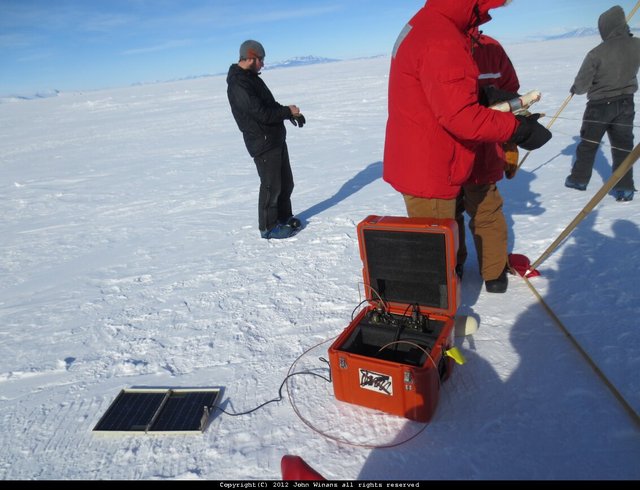This entry is because of a question I got from my son Nick. He’s an amateur radio operator (ham) and president of the Clemson University Ham Club. Thanks for the question and idea for this entry Nick!
 This is my son Nick trying to contact the South Pole in December 2011. Our antenna wasn't headed in the right direction, so he didn't make the contact. Maybe this year?!
This is my son Nick trying to contact the South Pole in December 2011. Our antenna wasn't headed in the right direction, so he didn't make the contact. Maybe this year?!
Communication is important to the scientists here in Antarctica. They need to let people know where they are, send data back to the main base in McMurdo, ask for supplies and equipment, and keep in contact with someone so that they know if bad weather is coming or if they need help because of an injury. Safety is the number one reason for having radio communication – this can be a dangerous place and there are lots of different hazards – equipment, cold, and winds. Reliable communications is the best safety tool we have in Antarctica.
In Antarctica there are three main ways to communicate when you are out at a field camp or away from the station. These are:
- VHF Radio – VHF stands for Very High Frequency. It works just like the FM radio you have at home, but it uses some special frequencies (wavelengths) to talk back and forth. VHF signals travel in a straight line and do not go through or over hills. This is called line-of-sight. That means if you could see far enough, the radio would work. Usually the antennas for VHF are put on the top of a mountain or a high spot so that they are in the open and can be hit by the signal from your radio. If you are in the field, your radio is a small hand-held radio that is like a walkie-talkie. Here at McMurdo the antenna for the VHF system is on the top of a mountain called Black Mountain because it’s a high point that’s out in the open so radios can reach it.
 VHF radios send their signal in a straight line. If there is a mountain in the way, the signal needs to go to the antenna on top of the mountain and then be re-transmitted to the other side. Image from Wikipedia.com
VHF radios send their signal in a straight line. If there is a mountain in the way, the signal needs to go to the antenna on top of the mountain and then be re-transmitted to the other side. Image from Wikipedia.com
- HF Radio – HF stands for High Frequency. HF radios can send their signals all over the world because they transmit the signal up into the atmosphere where it bounces off of certain layers in the atmosphere and back down to Earth. HF is used here in Antarctica in places where VHF won’t work. During our field camp we talked on HF radio from McMurdo to the South Pole. The South Pole is about away from where I am. HF radios need a bigger antenna than VHF. To make the antenna we used what is called a dipole antenna. A dipole is just two long pieces of wire that get strung between two poles. When it’s not being used, you wind the wire up and it takes up very little room. One disadvantage of HF radio is that if the sun is very active and producing solar storms, it can stop HF radio from working.
 HF can send radio signals world-wide. They do this because the signal bounces off of layers in the atmosphere and back down to earth. Image from radio-electronics.com.
HF can send radio signals world-wide. They do this because the signal bounces off of layers in the atmosphere and back down to earth. Image from radio-electronics.com.
 This is one of the HF radios used in Antarctica. It's portable and can use a solar charger to keep the batteries charged.
This is one of the HF radios used in Antarctica. It's portable and can use a solar charger to keep the batteries charged.
 Here we are in Happy Camper School setting up the dipole antenna to transmit from the HF radio. We talked to the South Pole on this radio.
Here we are in Happy Camper School setting up the dipole antenna to transmit from the HF radio. We talked to the South Pole on this radio.
- Iridium Satellite Telephone – One of the most recent advances in communication that works anywhere in the world is a satellite phone. This is a hand-held radio that transmits to a satellite that orbits the earth. The satellite re-transmits the signal from your phone back to earth where it goes into the normal phone system. I could call my wife in Mooresville, NC from the middle of the Ross Ice sheet on a satellite phone. These phones have taken over much of the communication in field camps because they are very reliable and don’t cost too much to use.
 Here I am during training using a satellite phone. I called my wife from a parking lot in Fairbanks, Alaska.
Here I am during training using a satellite phone. I called my wife from a parking lot in Fairbanks, Alaska.
Think about the history of exploration in Antarctica. Scott and Amundsen, who both reached the pole in 1911-1912, had no radios. It literally took a year before the rest of the world knew that they had succeeded in reaching the South Pole. Today you can talk to the South Pole by radio any time you want to. Science has created a reliable means of communication AND a critical safety net for people world-wide.

